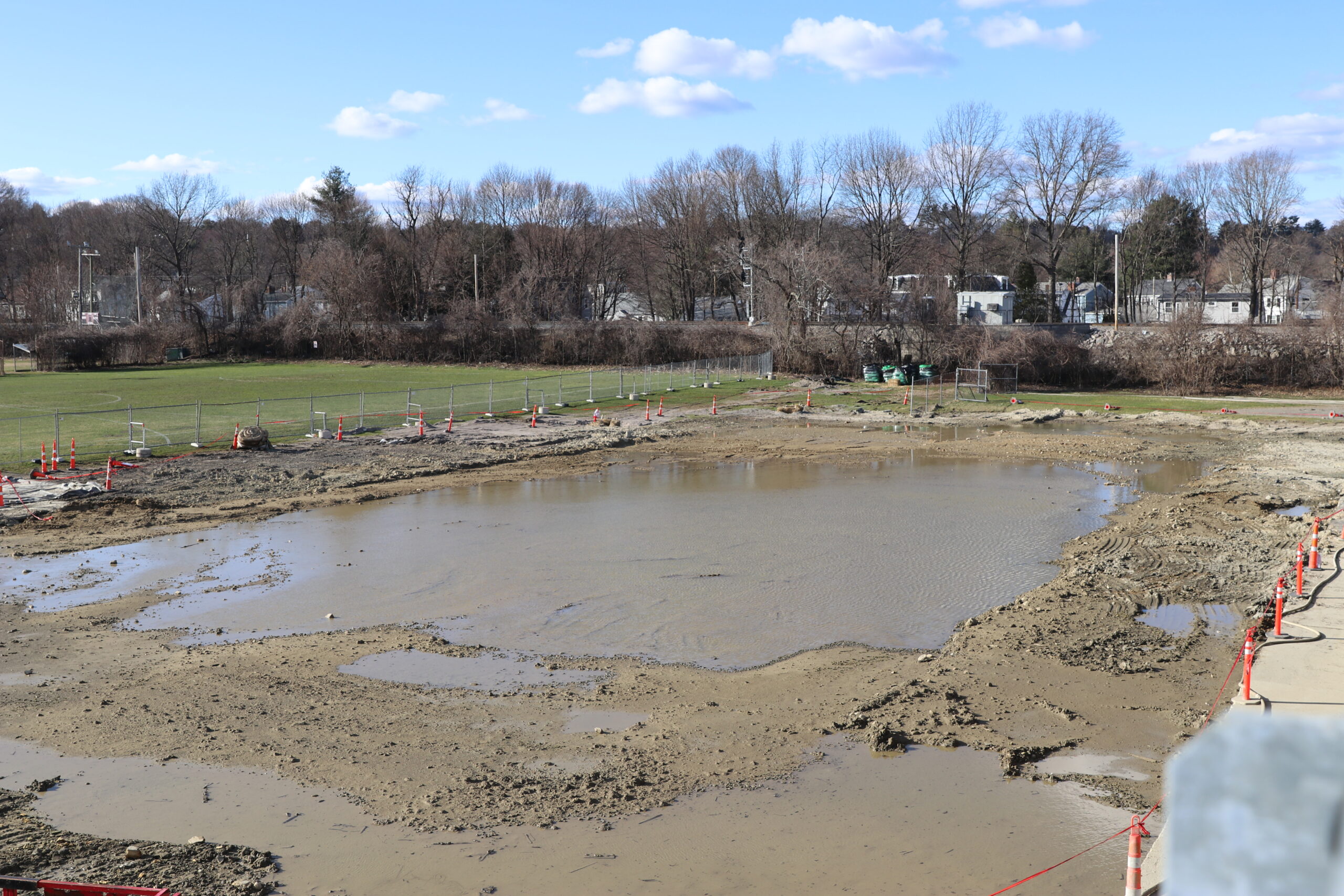Photo: All that remains of the former “Skip” rink is a large puddle.
There was a collective sigh of relief from the Municipal Skating Rink Building Committee last week as the $29.9 million project dodged two potentially worrisome environmental issues that turned out to be duds.
“We have two pieces of good news,” Rink Building Committee Chair Mark Haley told the committee.
In the first case, an underground fuel tank that was punctured during the building’s demolition had leaked “a small amount” of oil, which was mitigated as the soil was shipped off to an EPA-registered landfill. A second potential setback involving untreated asbestos discovered during the building’s tear-down was also limited to a part of the old rink’s slab where the ice was made.
“We hauled it away last week,” said Haley.
The meeting came as the committee is preparing to receive a first set of firm cost estimates from the builder Skanska—the general contractor for the Middle and High School project—on the cost of the rink’s construction, which has been a point of contention for several committee members.
“I have to ask a basic question: What’s the bottom line? I haven’t seen any numbers. What is the bottom line here?” asked Ann Marie Mahoney, a veteran of several building committees who has been requesting an overview.
Skanska – an international project development and construction company with a major office in Boston – has a typical construction contract with the town, as does Galante, the project’s architect. The building committee has employed CHA as the OPM (Owners Project Manager) to handle the project.
Over the past months, Skanska has been seeking cost estimates on some of the project’s major components, such as building the concrete foundation, ice surface, and mechanicals. Currently, the committee is working with broad estimates on each of the building’s components. Only with the cost estimates in hand can the building committee “understand the value of each of these elements, and then can we assess whether or not it’s worth the value to keep it or take it out,” said Haley.

Anticipating the likelihood of cuts, the rink’s architect, Ted Galante, has begun an early round of value engineering, a process of reviewing the building’s designs to reduce costs while increasing functionality to increase the product’s value. Haley points to “accouterments and adornments” that were added to spruce up the pre-engineered metal building, pointing to an overhang/canopy that is adjacent to the building’s entrance or a concrete masonry wall that runs along the base of the structure.
One area that will see a reduction in seating capacity is currently 400. “In a perfect world, we would have more seats, but state building codes would then require additional plumbing fixtures,” which would hike the overall cost, said Galante.
One decision that could affect long-term savings – but with a higher upfront price tag – is the system used to refrigerate the ice. Most of the building committee is leaning toward a CO2 system popular in Canada and at professional hockey rinks. Currently, the direct competitor to CO2 is Freon, a chlorofluorocarbon that is a highly potent greenhouse gas that faces increasing restrictions on its use by the federal government. While CO2 is low, the mechanical system tends to be more expensive as it relies on high pressure to work efficiently.
If the cost estimates come in on the high side in April, Haley said the committee will need to “take more of a cleaver” to the project, impacting the programs the rink was heralded to undertake for the school athletics and the town’s recreation department. But as of the meeting, he was hesitant to make any major adjustments to the new rink until he has the numbers in hand.
“We’ve been looking at how to effectively build the rink in a way that can navigate the budget and make sure we get the project we want,” said Haley. That’s why we don’t want to cut things out of the project now and then find out later that when we buy it all, we have to put things … back,” he said.
The committee continues to believe the rink will be ready for the start of the fall recreation department programs in 2025 and the high school hockey season of 2025-6.
[Correction: In an earlier version of this article, the project is a “design-build” project. That description was in error.]








Leave a Review or Comment